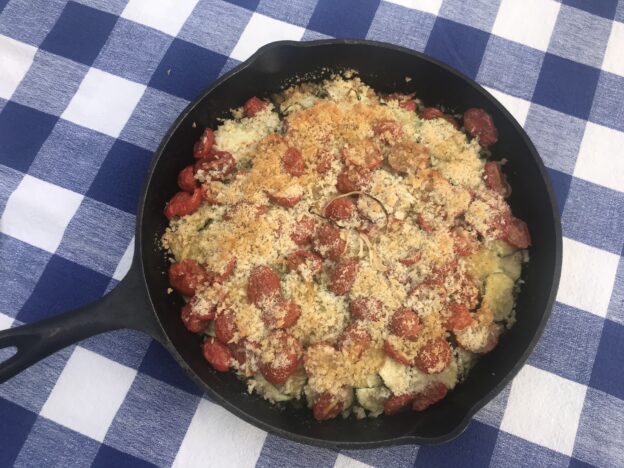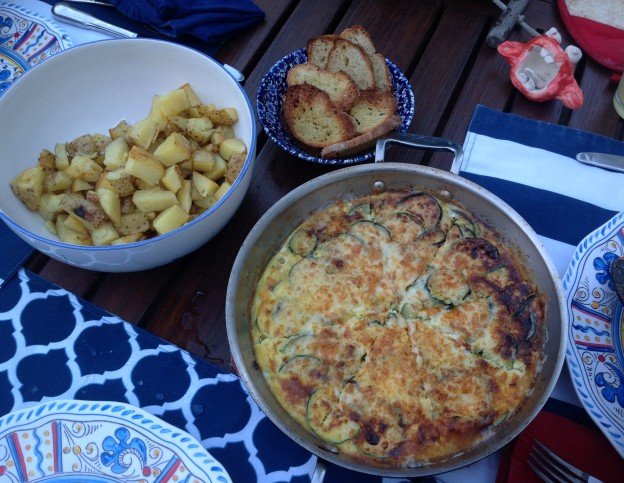The summer veggies are hanging in there, but we’re definitely bridging into squash and apple season. I’m looking to you, potatoes, to help us across that divide, by adding a little heft to the rest of the zukes and tomatoes.
Behold the tian, which is basically a whole lot of veggies layered over each other in sequence, each layer blessed with a drizzle of olive oil and a sprinkle of salt. The whole shebang is then topped with cherry or grape tomatoes and breadcrumbs and then melded together in the oven. It’s pretty brilliant in its simplicity and humble (until I bragged about it) elegance.
This recipe has the clever touch of being assembled over a low burner so the potato base layers get a little head start cooking. I’m including the whole recipe—as written by Chef Gabrielle Hamilton of Prune fame—but also giving you the Cliffs Notes, because this is more technique than exact recipe.
You’re melting the butter in the bottom of a big pan, making a base of two layers of sliced potatoes, then covering that with successive concentric layers of onions, zukes, potatoes, onions, zukes and finally all the tomatoes and a sprinkling on breadcrumbs. Each veggie layer gets its own drizzle of oil and a sprinkle of salt, and cooks along as you keep slicing away.
You can futz with amounts, but there are some key points to follow, starting with the your slicing. To get an A+ tian your potatoes, onions and zucchinis all need to be sliced thinly, hence the mandoline. If you don’t have one, I highly recommend springing for it. My $12 beauty is admittedly bare bones but it does the job and I still have all my fingers, so there’s that. On that note, do pay attention and use the protective pusher when you get anywhere near the end of your veggies. Those blades are sharp!
Also, the stove-top steaming step is key to cooking the potatoes. I got lazy and made a second tian by layering everything in my baking dish (some of us only own 1 cast iron pan) then putting it in the oven. It was good, but not great, mostly because the potatoes were not as perfectly cooked. If you go that route, cover your vessel with foil for the first half hour of cooking and leave it in for an extra 15 minutes, uncovered.
I also distilled the comments from the New York Times version of this recipe, which are many. They separate into two camps, both pretty indignant. The “How can you possibly not include garlic and fresh herbs in this?” camp and the “Keep it simple and let the fresh ingredients sing” camp. The latter crowd reminds us that the dish originated from a nonna in Puglia, and Pugliese hate garlic. Who knew? Thankfully, pretty much everybody agrees that blanching the tomatoes is only for teacher’s pets, and quite unnecessary.
Anyway, the bottom line is that both camps like this dish a whole lot, and with a long potato season in our future, it seems like a good time to get comfy making tian.
Ingredients:
- 2 tablespoons unsalted butter
- 3 medium Yukon Gold potatoes (about 12 ounces)
- Kosher salt and freshly ground black pepper
- ¼ cup extra-virgin olive oil
- 1 large yellow onion (about 12 ounces)
- 2 zucchini (about 12 ounces), washed and wiped free of any clinging grit
- 1 pint yellow Sungold cherry tomatoes
- ⅓ cup coarse bread crumbs
Method
- In a pot, boil 2 inches of water for blanching tomatoes (OR NOT). Place an 8- or 9-inch cast-iron skillet on a burner over low heat, and add butter to melt.
- Peel the potatoes, and slice on a Japanese mandoline into 1/4-inch-thick disks, then arrange in a single layer circle covering the bottom of the cast-iron skillet with its melted butter, keeping the skillet on the burner and leaving the heat on while you start to build the tian.
- Add a second layer of potato slices, and season with salt and pepper, add a drizzle of olive oil and cover with a lid to slightly steam while you slice the yellow onion.
- Peel the onion, then slice into even ¼-inch or thinner rounds. The Japanese mandoline is sometimes too narrow to use for this, so you may have to use a sharp knife and do it manually.
- Layer abundantly half the onion rings evenly around the pan on top of the steamed potatoes, season with salt and pepper and a drizzle of olive oil, and recover the pan with a lid while you slice the zucchini.
- Slice the zucchini into ¼-inch-thick rounds, and layer half of them in concentric, just-overlapping shingled circles over the onions to create a neat layer. Season with salt and pepper, drizzle with oil and recover with the lid while you blanch the tomatoes.
- (FOR OVERACHIEVERS ONLY) Season the now-boiling water with a few good pinches of salt, and drop the tomatoes into the boiling water. As soon as their skins split — about 30 seconds — retrieve the tomatoes and run under cold water to quickly cool enough to handle; set aside.
- Build another ring of potato around the tian on top of the now-steaming zucchini, this time just a single layer. Drizzle with oil, season with salt and pepper and recover with the lid to steam a bit while you slip the skins off the tomatoes (IF YOU MUST).
- Layer the other half of the onions as before, season and drizzle and replace the lid as before, while you split the tomatoes in half horizontally with a small sharp knife.
- Add final layer of zucchini to the tian, and season with salt and pepper and a drizzle of olive oil. Cover, and let steam while you heat the oven to 375 degrees.
- Place the tomatoes around the top of the tian evenly, and sprinkle the bread crumbs over the top evenly. Drizzle with oil, season with salt and pepper and place in the oven to bake for 30 minutes.* (If your skillet threatens to bubble over, slip a sheet pan underneath to prevent any burned wreckage in the bottom of your oven.)
- With a spoon, baste, and drizzle the pan juices that accumulate in the tian over the top when you remove it from the oven at the end. Allow the tian to cool, settle and kind of meld for an hour before eating.
*I’m pretty sure this is meant to go in uncovered though none of the bazillion comments actually answered this. Mine goes in uncovered, and it’s darned good.




